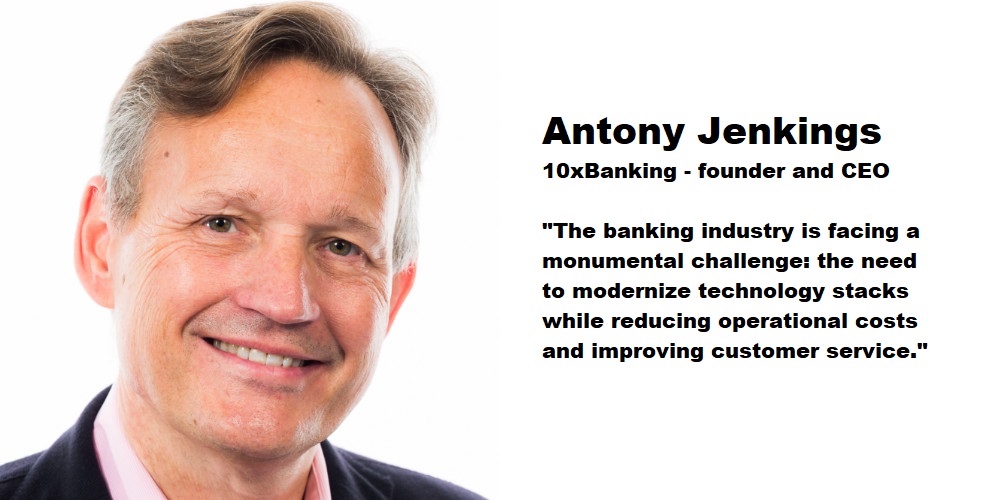
The financial services sector is still navigating an era of transformation defined by strategic innovation and an emphasis on customer needs. Over 2025, Antony Jenkins, Founder & CEO at 10x Banking foresee these to be the defining trends of the industry:
Technology stack migration and the role of AI
The banking industry is facing a monumental challenge: the need to modernize technology stacks while reducing operational costs and improving customer service. For mid-market and mutual banks, and building societies this challenge is especially pressing. These financial institutions often operate with complex legacy systems that are not only costly to maintain but also slow to innovate. However, the convergence of generative AI (Gen AI) and technology migration offers a promising solution – one that can streamline the transition to more efficient, real-time, and customerfocused banking platforms.
Gen AI: streamlining migration and reducing costs
One of the most compelling advantages of Gen AI is its ability to analyze and decode the complexities of legacy systems, creating migration paths and validating them with greater accuracy and affordability. The partnership between 10x and DLT Apps highlights this potential, showcasing how AI-driven tools can help banks overcome the often-overwhelming task of upgrading or replacing outdated systems. Yet, despite the promise of AI, only 32% of banks are currently utilizing AI at the core of their operations, according to our recent research, which leaves significant room for progress.
Developers can greatly benefit from AI during the migration process, as it reduces the risk of costly errors and provides a clearer path forward. This ability to streamline migration could significantly reduce the costs associated with these transitions, making them more manageable for institutions operating on tighter budgets. Ultimately, this will lower costs, improve efficiency, and allow for a more successful migration—a crucial consideration as banks look to stay competitive
Reducing cost-to-income ratios
As financial institutions strive to remain competitive, reducing cost-to-income ratios has become a critical focus. In an era where customers are demanding more for less—expecting zero fees on international transactions, better returns on savings, and seamless, frictionless banking experiences—banks need to find ways to deliver value without incurring additional costs.
A successful migration to a modern tech stack, underpinned by AI, is a strategic lever that can help banks lower their cost base.
Moreover, the banking landscape is evolving as customer expectations shift. Consumers no longer want to wait days for transactions or struggle with inefficient systems. Real-time capabilities are becoming a baseline expectation, and banks must respond. Real-time banking infrastructure is not just a competitive advantage—it is quickly becoming a necessity. By migrating to more agile, real-time technology stacks, banks can improve their responsiveness to customer needs, whether it’s fraud detection, customer service inquiries, or offering personalized financial products.
AI-ready data: the foundation for success
A major roadblock for AI adoption in banks is the lack of clean, integrated, and real-time data. At present, much of the data banks collect is disorganized and requires significant time and effort from data scientists to clean and prepare it for analysis. Without AI-ready data, the potential of generative AI to revolutionize banking operations remains largely untapped. To fully capitalize on AI’s capabilities, banks will need to ensure that the data within their core systems is clean, integrated, and actionable.
Consider, for example, the implications of AI in fraud detection or marketing optimization. If a bank’s AI model detects a potential fraud attempt, having access to realtime, accurate data would allow the system to respond immediately, potentially saving the bank from a significant loss. Similarly, if AI identifies an opportunity for targeted marketing, the ability to act quickly could provide a competitive edge. The need for AI-ready data is thus critical, and banks will have to prioritize transforming their core systems to make their data not only accessible but usable for AI applications.
The global opportunity: growth in Africa and APAC
As the banking industry looks to modernize, high-growth regions such as Africa and Asia-Pacific (APAC) present unique opportunities. Many banks in these emerging markets are not as encumbered by complex legacy systems as their counterparts in more developed regions like the UK or US. This gives them a distinctive advantage as they seek to leverage AI to modernize and capitalize on new technologies.
In Africa, for example, the banking sector is playing a crucial role in driving societal progress. By facilitating access to capital, banks are supporting the growth of key sectors like agriculture, thereby contributing to broader economic development. Take Old Mutual in Africa, for instance. By implementing AI and upgrading its technology stack, the institution has been able to streamline operations, improve customer engagement, and expand its market share in the region.
As banks in these regions look to build on the momentum of their early digital transformations, they are poised to leapfrog legacy systems and deploy real-time, AI-driven banking platforms faster than many of their counterparts in the West.
_________
10xBanking spoke to senior figures from the likes of AWS, Google and GFT to get their take on how the financial services industry will change in 2025. More details here: 2025 trends – the future of banking
Banking 4.0 – „how was the experience for you”
„To be honest I think that Sinaia, your conference, is much better then Davos.”
Many more interesting quotes in the video below: